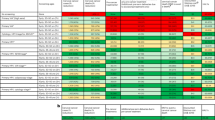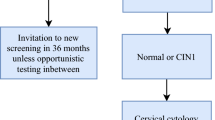Abstract
The screening histories of all 348 women with invasive cervical cancer diagnosed in 1992 in 24 self-selected district health authorities and health boards in England, Wales and Scotland were compared with those of 677 age- and residency-matched controls. The controls were randomly selected from the family health services authority (FHSA) register. Screening histories, comprising the dates and results of all smears taken before the date of diagnosis of the patient's cancer, were determined from the FHSA computer and laboratory records. We estimate that the number of cases of cervical cancer in participating districts in 1992 would have been 57% (95% confidence interval 28-86%) greater if there had been no previous screening. In women under the age of 70 it would have been approximately 75% (31-115%) greater. Extrapolation of the results from this pilot suggests that screening prevented between 1100 and 3900 cases of invasive cervical cancer in the UK in 1992. Women with stage 1B cancer or worse were more likely to have no record of previous screening than controls: 47% of these women under the age of 70 had been adequately screened according to current (5 yearly screening) guidelines, compared with 75% of matched controls. Thirteen per cent of all patients under age 70 had screening histories indicative of inadequate follow-up of smears requiring colposcopy. The proportion of microinvasive cases with screening predating diagnosis was similar to the proportion of controls. There was a strong correlation between stage and age: 56% of cancers in women under 35 were microinvasive compared with just 9% in women 65 years or over. The 'relative protection' following a negative smear was greatest in the first 12 months and fell off towards the end of the fifth year. These data suggest that full adherence to current guidelines could perhaps have prevented another 1250 cases, but additional steps would have been required to prevent some of the 2300 remaining cases in women under the age of 70.
This is a preview of subscription content, access via your institution
Access options
Subscribe to this journal
Receive 24 print issues and online access
$259.00 per year
only $10.79 per issue
Buy this article
- Purchase on Springer Link
- Instant access to full article PDF
Prices may be subject to local taxes which are calculated during checkout
Similar content being viewed by others
Author information
Authors and Affiliations
Consortia
Rights and permissions
About this article
Cite this article
Sasieni, P., Cuzick, J., Lynch-Farmery, E. et al. Estimating the efficacy of screening by auditing smear histories of women with and without cervical cancer. Br J Cancer 73, 1001–1005 (1996). https://doi.org/10.1038/bjc.1996.196
Issue Date:
DOI: https://doi.org/10.1038/bjc.1996.196
This article is cited by
-
Uptake and acceptability of human papillomavirus self-sampling in rural and remote aboriginal communities: evaluation of a nurse-led community engagement model
BMC Health Services Research (2020)
-
A fluorometric hybridization assay for detecting and genotyping high-risk human papillomavirus 16 and 18 in archival tissues of cervical specimens
Brazilian Journal of Microbiology (2020)
-
Age-related acceptability of vaginal self-sampling in cervical cancer screening at two university hospitals: a pilot cross-sectional study
BMC Public Health (2019)
-
Resilience of a FIT screening programme against screening fatigue: a modelling study
BMC Public Health (2016)
-
Human Papillomavirus (HPV) Testing for Secondary Prevention of Cervical Cancer
Current Obstetrics and Gynecology Reports (2015)



